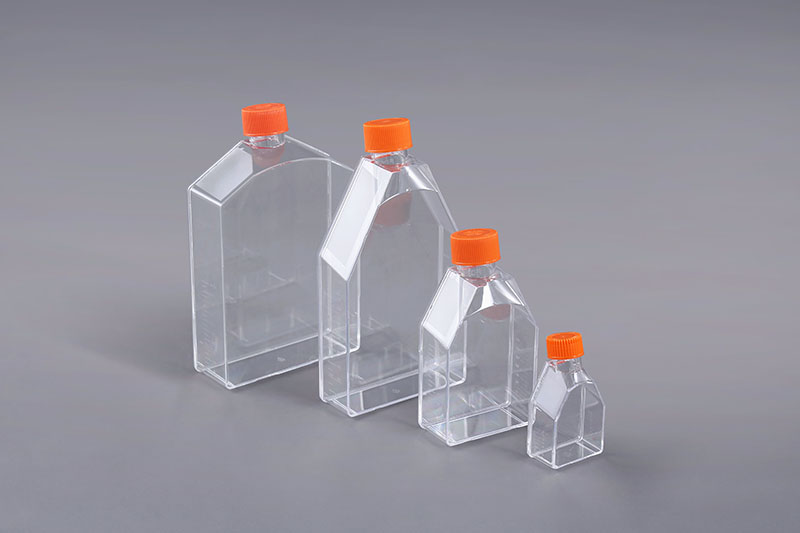एडहेरेंट सेल: वेरो सेल, HEK 293 सेल, CAR-T सेल, MRC5, CEF सेल, पोर्सिन एल्वोलर मैक्रोफेज, मायलोमा सेल, DF-1 सेल, ST सेल, PK15 सेल, मार्क 145 कोशिकाओं, आदिमुख्य रूप से छोटे और मध्यम स्तर के सेल कल्चर के लिए उपयोग किया जाता है, तो सेल कल्चर फ्लास्क में किस तरह की कोशिकाओं को कल्चर किया जा सकता है? उनके विकास पैटर्न के अनुसार। अनुयाई कोशिकाओं के विकास में एक समर्थन सतह होनी चाहिए जिसे संलग्न किया जा सकता है, और कोशिकाएं स्वयं द्वारा स्रावित या संस्कृति माध्यम में प्रदान किए गए लगाव कारकों पर निर्भर करती हैं। इस सतह पर बढ़ने और पुन: उत्पन्न करने के लिए। निलंबन कोशिकाओं की वृद्धि समर्थन की सतह पर निर्भर नहीं करती है और संस्कृति माध्यम में निलंबन में बढ़ती है। सेल कल्चर फ्लास्क आम तौर पर पारदर्शी पॉलीस्टाइनिन कच्चे माल से बने होते हैं। सामान्य विशिष्टताओं में 25cm2, 75cm2, 175cm2, और 225cm2 शामिल हैं। सेल फ्लास्क की निचली सतह को कोशिकाओं को पाइप करते समय संपर्क मृत कोणों को कम करने के लिए एक चाप आकार के साथ डिज़ाइन किया गया है। इसका उपयोग अनुयाई कोशिकाओं की संस्कृति और निलंबन कोशिकाओं की स्थिर संस्कृति दोनों के लिए किया जा सकता है। लागू सेल प्रकार इस प्रकार हैं:
निलंबन कोशिकाएँ: CHO कोशिकाएँ, कीट कोशिकाएँ, BHK21 कोशिकाएँ और MDCK कोशिकाएँ, आदि। आसन्न कोशिकाओं की वृद्धि विशेषताओं को पूरा करने के लिए इसकी हाइड्रोफिलिसिटी को बढ़ाने के लिए फ्लास्क को विशेष रूप से संशोधित करने की आवश्यकता है। जब सस्पेंशन सेल कल्चर में उपयोग किया जाता है, तो किसी विशेष उपचार की आवश्यकता नहीं होती है।
सेल कल्चर फ्लास्क
Suspension cells: CHO cells, insect cells, BHK21 cells and MDCK cells, etc.
It should be noted that if the cell culture flasks are used for the cultivation of adherent cells, the surface of the flask needs to be specially modified to increase its hydrophilicity to meet the growth characteristics of adherent cells. When used in suspension cell culture, no special treatment is required.
The FAI climbed 5.9 percent year-on-year in the first 11 months of 2018, quickening from the 5.7-percent growth in Jan-Oct, the National Bureau of Statistics (NBS) said Friday in an online statement.
The key indicator of investment, dubbed a major growth driver, hit the bottom in August and has since started to rebound steadily.
In the face of emerging economic challenges home and abroad, China has stepped up efforts to stabilize investment, in particular rolling out measures to motivate private investors and channel funds into infrastructure.
Friday's data showed private investment, accounting for more than 60 percent of the total FAI, expanded by a brisk 8.7 percent.
NBS spokesperson Mao Shengyong said funds into weak economic links registered rapid increases as investment in environmental protection and agriculture jumped 42 percent and 12.5 percent respectively, much faster than the average.
In breakdown, investment in high-tech and equipment manufacturing remained vigorous with 16.1-percent and 11.6-percent increases respectively in the first 11 months. Infrastructure investment gained 3.7 percent, staying flat. Investment in property development rose 9.7 percent, also unchanged.
 English
English



















































